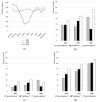STIs during the COVID-19 Pandemic in Hungary: Gonorrhea as a Potential Indicator of Sexual Behavior
- PMID: 35954984
- PMCID: PMC9368208
- DOI: 10.3390/ijerph19159627
STIs during the COVID-19 Pandemic in Hungary: Gonorrhea as a Potential Indicator of Sexual Behavior
Abstract
The social distancing measures introduced due to the COVID-19 pandemic may have affected the sexual behavior of the population. We collected data retrospectively from the National STD Center of Hungary. The overall patient influx data of the STD Center and the number of patients diagnosed with syphilis, chlamydia, and gonorrhea infections were assessed in the three-month period of 2020 when the strict governmental lockdown was introduced in Hungary. Data were compared to the pre- and post-lockdown quarters of 2020 and matched to the respective quarters of 2018 and 2019. The number of patients diagnosed with syphilis and chlamydia infections in 2020 during the lockdown decreased compared to 2018 and 2019, while the number of gonorrhea cases increased. The lower number of STI screenings resulted in a significant decrease in asymptomatic syphilis and chlamydia case numbers. However, the growing number of gonorrhea cases in 2020 during lockdown highlights that sexual behavior remained unchanged regardless of restrictions. Therefore, gonorrhea may be considered as an indicator of STI incidences during the pandemic.
Keywords: COVID-19; STI; sexual behavior; sexually transmitted infection.
Conflict of interest statement
The authors declare no conflict of interest.
Figures

References
-
- Merkely B., Szabó A.J., Kosztin A., Berényi E., Sebestyén A., Lengyel C., Merkely G., Karády J., Várkonyi I., Papp C., et al. Novel coronavirus epidemic in the Hungarian population, a cross-sectional nationwide survey to support the exit policy in Hungary. Geroscience. 2020;42:1063–1074. doi: 10.1007/s11357-020-00226-9. - DOI - PMC - PubMed
MeSH terms
LinkOut - more resources
Full Text Sources
Medical
Research Materials

